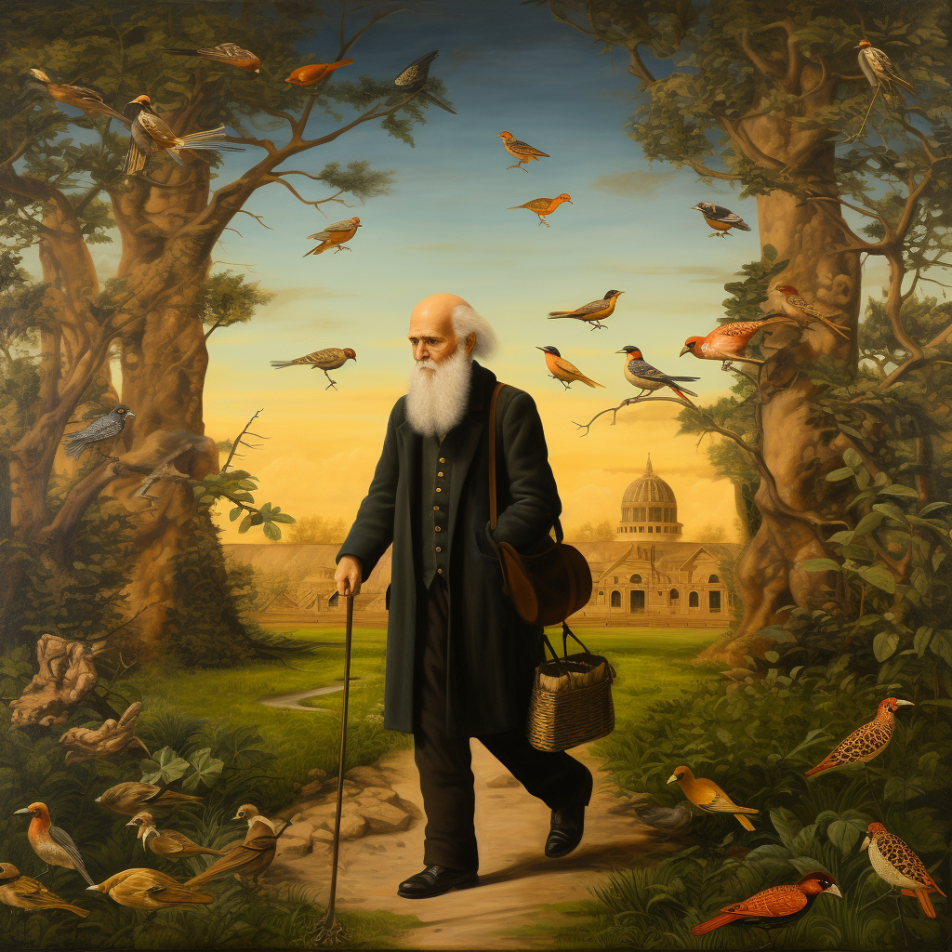During the lockdown when the roads were quiet and the chirping of birds where audible, I would regularly go for a walk through my local park in the mornings and/or after work. I did this because it was the only thing we were allowed to do. It was my only way of feeling free and connected to the natural world.
Looking back, I noticed that not only was I somewhat at peace (even during the midst of a pandemic) but I was also more creative. I would regularly jot down ideas on my phone and some of those ideas have materialised quite well now.
Finally, after some investigation, I put my increase in creativity down to being in nature. I was partially correct.
Since then, through exploratory reading, I began learning about the day to day routines of some of mankind’s greatest thinkers and stumbled upon a common theme.
They all walked, and incessantly too.
In fact, I believe walking was their pathway to higher levels of thought and creativity.
Wise men walk.
Walking back in time
In his middle and later years, Charles Darwin, would typically go for a walk three times a day. This rigid routine seldom changed, even when there were visitors in his house. During his midday walk, Darwin went on his constitutional stroll round the “Sand-walk” – a narrow strip of land measuring one and a half acres that was planted by Darwin himself with a variety of trees and long hollies all down the exposed side. Darwin would walk with a swinging action using a walking stick heavily shod with iron. The scientist enjoyed watching his children play here and it is believed that Darwin’s greatest thoughts were cultivated along this path.
“All truly great thoughts are conceived while walking” wrote Friedrich Nietzsche, a probable self-reflection. Nietzsche was an avid walker and would go for a “brisk, two-hour walk through the nearby forest or along the edge of Lake Silvaplana (to the north-east) or of Lake Sils (to the south-west), stopping every now and then to jot down his latest thoughts in the notebook he always carried with him” writes Curtis Cate in Friedrich Nietzsche: A Biography. After lunch, alone (he preferred it that way), Nietzsche regularly found himself with a pencil and notebook striding off again on an even longer walk around the valleys of Switzerland.
Henry Thoreau, the American essayist, poet, philosopher and lifelong abolitionist understood the value of sauntering so much so that in 1861 he released his essay titled ‘Walking’. For Thoreau, walking was more of a spiritual act that connected him to nature rather than exercise. “I am alarmed when it happens that I have walked a mile into the woods bodily, without getting there in spirit.” he wrote.
The German philosopher, Arthur Schopenhauer, would go for a two hour walk after his lunch whatever the weather. Not a particular health-freak, no one really knew why he was so stubborn in his ways. He possibly felt similarly to Jean-Jacques Rousseau, who famously wrote that “I can only meditate when I am walking, when I stop I cease to think; my mind only works with my legs.'.
Walking has aided creative and deep thinking for thousands of years. Hippocrates said, “Walking is a man’s best medicine” and Aristotle conducted lectures whilst walking the grounds of his school in Athens. His avid listeners would follow him as he strolled and spoke.
Walking may have aided some of today’s most pivotal innovations. Steve Jobs, like Aristotle, did a lot of his creative thinking whilst walking. Jobs’ preferred way to have serious conversations was whilst walking long walks.
Naval Ravikant, also feels the same way about meetings. In his blog ‘Be Too Busy to ‘Do Coffee’’, he writes “You have to be utterly ruthless about dodging meetings. When you do meetings, make them walking meetings.’’.
You can talk the talk but can you walk the walk?
Walking has been studied scientifically and has been shown to potentially increase certain areas of the brain as well as reduce the risk of developing cognitive impairment. A longitudinal study assessed over a thousand adults over the age of 65. Information about lifestyles and physical function were collected as part of this study including information on the frequency and duration of walking. After 9 years these same participants were recruited to participate in a brain MRI study in which high-resolution brain images were collected. MRI images of 299 cognitively healthy adults showed that greater amounts of walking was associated with greater grey matter volume in several parts of the brain including the frontal cortex (the area involved with problem solving and reasoning) and temporal cortex (including the hippocampus – the memory centre of the brain). If like this wasn’t enough, after a period of 4 more years, 116 out of these 299 participants were diagnosed with either mild cognitive impairment or dementia, but greater grey matter volume associated with physical activity was associated with a two-fold reduced risk of developing cognitive impairment. Or in other words by walking at least 1 mile a day, they had reduced their risk of cognitive impairment by approximately 50%.
Walking has also been studied in preadolescent children and academic achievement. Children aged around 10 years old were asked to perform cognitive tests first whilst rested and then later after walking on a treadmill. Results showed an improvement in response accuracy and better performance on the academic achievement test following walking on the treadmill. Throughout the study the children also had 45 electrodes placed on their heads to measure event related potentials (ERP). ERPs are the brains measure of response to stimuli and a means to non-invasively study the brain. The P300 (P3) wave is an ERP involved in decision making. The size of the P3 wave (amplitude) is believed to reflect the allocation of attention during engagement of a task – the bigger the wave the more focused (in essence). As well as doing better on tests after their short walk – children also had larger P3 wave amplitudes – the brain was using more of its power for focus.
But why?
Before we get into the why, we have to understand the difference between divergent thinking and convergent thinking.
Divergent thinking is a type of creative thinking where one generates ideas by exploring many possible solutions. By divergent thinking, one essentially is thinking outside the box, thoughts are free flowing and non-linear. One way to measure divergent thinking is by using the Guilford’s alternate uses (GAU) test. The GAU depends on cognitive flexibility and asks people to generate alternate uses for common objects such as a button or tire in a given allocated time – e.g. button “a doorknob for a dolls house….an eye for a doll”.
Convergent thinking is the opposite of divergent thinking. Convergent thinking is the ability to work from the outside in and to formulate one correct answer. It is the type of thinking used in most tests in school and does not particularly incorporate creative thinking. The compound remote-association test (CRA), is a widely adopted measure of convergent thinking. In this test people are given three words and asked to produce a single word that combines with each of the three words – e.g. “cottage – Swiss – cake” – cheese would be the answer.
In the aptly titled study ‘Give Your Ideas Some Legs: The Positive Effect of Walking on Creative Thinking’ – a handful of mini experiments demonstrated that walking boosts creative thinking in real time and shortly after. In one experiment participants were asked to complete the CRA and GAU whilst seated and then later on a treadmill. Walking was shown to increase 81% participants creativity on the GAU, but only increased 23% of participants score on CRA. Very interestingly, the experiments demonstrated that participants exhibited a residual creative boost after walking (raised GAU scores seated after a period of walking). Walking outside (rather than a treadmill) also produced the most novel and highest quality analogies.
There are possible explanations for the cognitive benefits of walking. One is that walking taxed the brains ability to handle the nature of walking as well as thinking. The side-effect of this distraction was it allowed more creativity to seep in. An alternate explanation may be that walking may relax suppression of memories which in turn may increase thoughts associated to those memories and thus more creative thinking.
“Walking opens up the free flow of ideas and it is a simple and robust solution to the goals of increasing creativity and increasing physical activity” – note the experimenters.
Where you walk is important.
Attention restoration theory (ART) is based on research showing a difference between involuntary attention and voluntary/directed attention. Involutory attention is where attention is captured by inherently intriguing or important stimuli – e.g. by a loud noise in the room. Whereas directed attention is where attention is directed by cognitive control – e.g. reading a book.
According to ART, interacting in environments rich with inherently fascinating yet subtle stimuli (e.g. trees, sunsets etc) invoke involuntary attention modestly, this allows directed attention a chance to rest and replenish. After interacting with nature – one should perform better on tasks that depend on directed-attention abilities.
A paper titled ‘The Cognitive Benefits of Interacting with Nature’ explored ART by first asking participants to complete a backward digit span (a test where participants heard digit sequences and were required to repeat them backwards). They were then later asked to either walk in nature or walk downtown. Tests were repeated after the walk. Results showed that performance on the test significantly improved after walking nature but not downtown. In the second part of the experiment, participants were shown either pictures of nature or urban areas. After testing, participants performed better after viewing images of nature and not urban areas.
The experimenters here state: “…these experiments demonstrate the restorative value of nature as a vehicle to improve cognitive functioning.”. Ultimately, nature acts a small distraction, allowing the cognitively demanding thinking part of our brains to rest and restore and thus work more effectively when needs be.
Walk, walk, walk, walk, walk
To really supercharge your creativity and boost cognition I believe you should walk at least once a day, with no phone or music through beautiful places of nature. Bring a pen and notepad and jot any ideas down. Take the surrounding beauty in and appreciate where you currently are.
Many of our greatest thinkers have all enjoyed walking. I strongly believe that if they hadn’t gone on long strolls, they would not have reached the pivotal ideas that changed the world. Walk through nature and you will literally change your mind. An easy stroll may even protect you from cognitive decline.
Go for a walk and let your mind run free.


